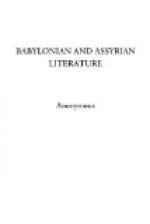This is a very frequent subject of the tablets. [Footnote: Taken from 2 R pl. 18.] One of them says of a sick man:
1 “May the goddess ... 2 wife of the god ... 3 turn his face in another direction; 4 that the evil spirit may come out of him 5 and be thrust aside, and that Good Spirits and Good Powers 6 may dwell in his body!”
Sometimes divine images were brought into the chamber, and written texts taken from holy books were placed on the walls and bound around the sick man’s brows. If these failed recourse was had to the influence of the mamit, which the evil powers were unable to resist. On a tablet 2 R p. 17 the following is found, written in the Accadian language only, the Assyrian version being broken off:
1 Take a white cloth: In it place the mamit, 2 in the sick man’s right hand. 3 And take a black cloth: 4 wrap it round his left hand. 5 Then all the evil spirits.[1] 6 and the sins which he has committed 7 shall quit their hold of him, 8 and shall never return.[2]
[Footnote 1: A long list of them is given.]
[Footnote 2: “Trans. Soc. Bib. Arch.,” vol. ii. p. 56.]
The symbolism of the black cloth in the left hand seems evident. The dying man repudiates all his former evil deeds. And he puts his trust in holiness, symbolized by the white cloth in his right hand. Then follow some obscure lines about the spirits—
Their heads shall remove from his head:
their hands shall let go his hands:
their feet shall depart from his feet:
which perhaps may be explained thus—we learn, from another tablet, that the various classes of evil spirits troubled different parts of the body. Some injured the head, some the hands and feet, etc., etc. Therefore the passage before us may mean: “The spirits whose power is over the hand, shall loose their hands from his,” etc. But I can offer no decided opinion on such obscure points of their superstition.
INHERITED OR IMPUTED SINS
These were supposed to pursue a sick man and torment him. [Footnote: See “Cuneiform Inscriptions of Western Asia,” vol. iv. p. 7.]
1 The mamit for him reveal! The mamit for him unfold![1] 2 Against the evil spirit, disturber of his body! 3 Whether it be the sin of his father: 4 or whether it be the sin of his mother: 5 or whether it be the sin of his elder brother: 6 or whether it be the sin of someone who is unknown![2]
[Footnote 1: A holy object, the nature of which has not been ascertained.]
[Footnote 2: “Trans. Soc. Bib. Arch.,” vol. ii, p. 58.]
MAGIC KNOTS
Justin Martyr, speaking of the Jewish exorcists, says “They use magic ties or knots.” A similar usage prevailed among the Babylonians. [Footnote 7: Ibid., p. 54.] The god Marduk wishes to soothe the last moments of a dying man. His father Hea says: Go my son!




